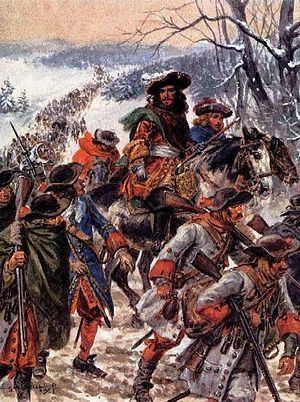30,000 soldiers 50,000 soldiers Result French victory | Date 5 January 1675 | |
 | ||
Similar Battle of Sinsheim, Battle of Saint‑Denis, Battle of Salzbach, Battle of Entzheim, Battle of Stromboli | ||
Battle of turckheim
The Battle of Turckheim was a confrontation during the Franco-Dutch War fought on 5 January 1675 between the towns of Colmar and Turckheim in Alsace. The French army, commanded by the Viscount of Turenne, fought against the armies of Austria and Brandenburg, led by Frederick William, Elector of Brandenburg.
Contents
Prelude
The aggressive campaign of Louis XIV against the Netherlands, since 1672, had provoked a hostile reaction of other European states like Austria (who controlled the Holy Roman Empire) and Brandenburg. Their intervention had brought the war into the upper Rhine, creating a threat to French territory. In 1674 Marshal Turenne, French commander in that sector, failed to prevent the invasion of Alsace by a part of the imperial army. With the arrival of year's end in 1674, the Imperials went into their winter quarters in the region of Colmar, a few miles south of the French winter barracks, situated in Haguenau.
According to the conventions of war at the time, the military operations should have been halted during the winter until the return of the spring. Turenne, however, decided not to follow this custom. Using the Vosges mountains as a curtain of protection, he moved west and then south, reappearing in Belfort, south of his opponent, on 27 December 1674. Finding no resistance, he reached Mulhouse on the 29th. The highly surprised Imperials hastily fell back on Turckheim.
Battle
Turenne with 30,000 troops found the Imperial army very well positioned with 30,000 to 40,000 men under the command of Frederick William, the Elector of Brandenburg-Prussia, on the afternoon of 5 January 1675. However, the Imperial forces had not yet gelled completely so as to be ready for battle. The ensuing battle did not follow the standards of the 17th century. Marshal Turenne feigned an attack from the center and then another from his right. With Imperial eyes riveted on these two parts of the front, Turenne led a third of his army on a march around to his left flank. Their movement skirted the mountains and was hidden from view of the enemy because of the terrain. Turenne captured the small village of Turckheim. Frederick William attempted to retake the town but he was defeated by heavy fire from French guns and an infantry charge. Turenne, then, fell against the extreme right of the enemy. The speed of the attack (which was not preceded by artillery fire) and the numerical superiority concentrated on a single point, disrupted and demoralized the defenders, putting them to flight after suffering 3,000 casualties, retreating to avoid further casualties.
Aftermath
Now, with their winter quarters threatened, Frederick William of Brandenburg's army was forced to leave Alsace, and sought the safety of Strasbourg where the army in the following week crossed the Rhine River, back onto the right bank into present-day Germany.
This brief and but famous winter campaign by Marshal Turenne is considered one of the brightest of the 17th century. Here the Vicomte de Turenne, through two indirect maneuvers (one strategic and one tactical) saved France from invasion, suffering only negligible casualties.
